
When it comes to marijuana, just like other products that are derived from plants and grown in varying conditions, it is hard to pick a favorite. For decades, most of the marijuana consumed in the U.S. was homegrown or imported from unregulated growers. Even if you got your marijuana from the same dealer, there was no way of knowing that it was the same stuff.
Medical marijuana offers the advantage of being professionally cultivated for a consistent product. There are still thousands of variations available, but research has mapped the active ingredients in cannabis, and commercial growers can more accurately produce plants with the right balance of chemical compounds to be helpful.
Identifying the best strains of medical marijuana is not about picking a favorite. Instead, we can look at the effects each strain has on common conditions it is used to treat and name the most beneficial, and most popular, strains of medical marijuana.
Cannabinoids, the chemical structures in cannabis, are what produce the effects you feel when you use marijuana. Studies of the three types of cannabis plants — indica, sativa and ruderalis — identified at least 86 cannabinoids. The exact effect of each of these cannabinoids is not yet known, but the more powerful ones are understood.
Every hybrid strain of marijuana includes a different balance of these 86 compounds, which is one of the reasons that homegrown weed varies so much. If you took the number of different people growing marijuana and multiplied it by 86, you would get a pretty good idea of how complex the study of marijuana really is.
The primary cannabinoid that produces the mind-altering effects of marijuana is delta-g-tetrahydrocannabinol (THC). The amount of THC in a particular strain of medical marijuana is significant for predicting its effects and comparing it to other strains. Hemp, an inactive form of cannabis, contains less than a 0.5% concentration of THC. Medical marijuana can have THC concentrations as high as 20% or more.
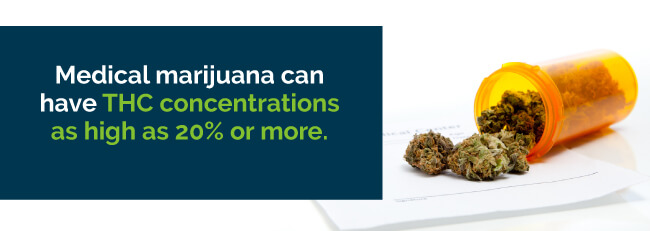
The average marijuana plant grown in your friend’s basement probably contains about a 4% concentration of THC. Higher-grade strains of marijuana can range from 4% all the way up to 20%. To get a higher concentration of THC, you can move into extracts, tonics and tinctures.
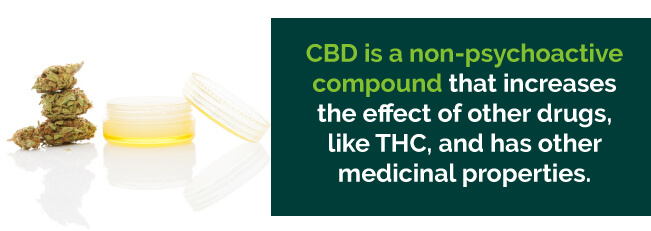
Another common element found in cannabis is cannabidiol (CBD). This non-psychoactive compound increases the effect of other drugs, like THC, and has other medicinal properties. CBD reduces anxiety and panic attacks. It also helps protect damaged nerves, reduces seizures and induces relaxation and sleep.
CBD is found in high levels in hemp and much lower levels in cannabis plants that are naturally higher in THC. For breeding plants to contain more THC, growers naturally reduce the plant’s ability to develop CBD. Although these two elements work well together, they compete in the plant for the same derivative materials. The key to a good medical marijuana strain is the right balance of THC and CBD to treat the medical condition that is present.
There are thousands of marijuana strains, and new ones are developed all the time. Choosing the right strain for you will require some personal experimentation. Each strain of medical marijuana will have a slightly different effect on each patient, furthering the need to try a few before deciding which one is best.

Different strains of marijuana are identified by interesting and sometimes unusual, or ironic, names. The names usually help identify the cannabis plants by some distinguishing feature. Girl Scout Cookies, for example, have a slightly sweet aroma, and Strawberry Cough has a definite berry flavor. Jamaican Lion is a hybrid of Mountain Lion and a Jamaican strain of sativa.
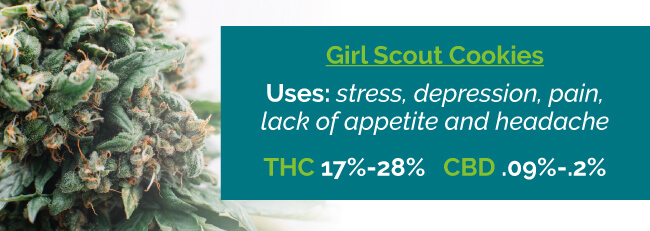
Other strains of medical marijuana are named after people, like Dr. Grinspoon, named after a cannabis advocate from the 1970s. Another popular strain that hits you quickly is Bruce Banner, named after The Incredible Hulk. This marijuana strain appears like mild-mannered Bruce Banner but quickly turns into a green monster.
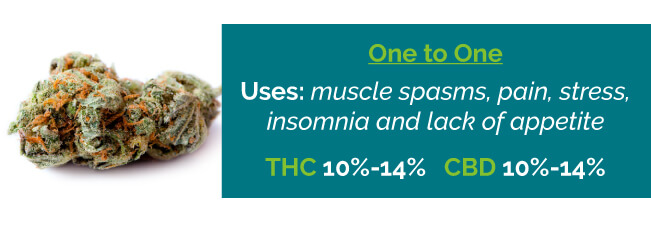
One useful name is One to One, which refers to an equal balance of THC and CBD. To decipher the meaning of Super Sour Diesel, you have to know it is a hybrid of Sour Diesel and Super Silver Haze. Super Silver Haze is a mix of three other strains including one named Haze, which dates back to the 1960s and is part of several other hybrids.
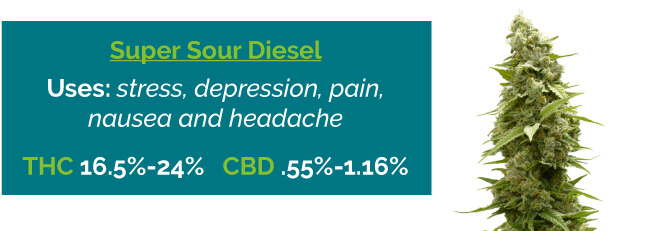
The names of medical marijuana strains only offer a small hint of what they are good for. Here is a list of top medical marijuana strains and some useful information about each one:
| Name | THC | CBD | Uses | Side Effects |
| Girl Scout Cookies | 17-28% | 0.09-0.2% | stress, depression, pain, lack of appetite and headache | dry mouth, dry eyes, paranoia, anxiety and dizziness |
| OG Kush | 19-26% | 0-0.3% | stress, pain, depression, insomnia and headaches | dry mouth, dry eyes, dizziness, paranoia and anxiety |
| Harlequin | 4-7% | 8-16% | pain, stress, depression, inflammation and headache | dry mouth, dry eyes, anxiety, dizziness and headache |
| Strawberry Cough | 20-23% | 0.05-0.4% | stress, depression, pain, fatigue and lack of appetite | dry mouth, dry eyes, headache, dizziness and paranoia |
| One to One | 10-14% | 10-14% | muscle spasms, pain, stress, insomnia and lack of appetite | dry mouth, dry eyes, dizziness and paranoia |
| Atomic Northern Lights | 10-12% | 0.10-0.3% | stress, pain, depression, insomnia and lack of appetite | dry mouth, dry eyes, dizziness, paranoia and headache |
| Bruce Banner | 16-26% | 0.1-0.6% | stress, depression, pain, fatigue and headache | dry mouth, dry eyes, dizziness, paranoia and anxiety |
| Blue Dream | 17-24% | 0.1-0.2% | stress, depression, pain, headache and fatigue | dry mouth, dry eyes, paranoia, dizziness and anxiety |
| Green Crack | 13-21% | 0-0.15% | stress, depression, fatigue, pain and lack of appetite | dry mouth, dry eyes, paranoia, anxiety and headache |
| Super Sour Diesel | 16.5-24% | 0.55-1.16% | stress, depression, pain, nausea and headache | dry mouth, dry eyes, anxiety, paranoia and dizziness |
| Jamaican Lion | 5-9% | 18-23% | stress, pain, depression, muscle spasms and inflammation | dry mouth, dizziness, dry eyes, headache and paranoia |
| Crimea Blue | 15-18% | 0.5-1.5% | eye pressure, pain, depression, stress and insomnia | dry mouth and dizziness |
| G-13 Haze | 18-21% | 0.10-0.7% | stress, pain, insomnia, depression and eye pressure | dry mouth, dry eyes, dizziness, anxiety and paranoia |
| Dr. Grinspoon | 17-25% | 0-0.4% | depression, fatigue, stress, lack of appetite and pain | dry mouth, dizziness, dry eyes and paranoia |
Lists of top medical marijuana strains vary from different resources and different years. There are always new strains to consider, and sometimes a new strain becomes popular for the treatment of a certain condition. Since all strains are hybrids derived from older ones, even the new strains maintain some sense of familiarity.
The side effects of medical marijuana treatment are based on getting the right balance of THC and CBD for your condition. Using medical marijuana can cause a panic reaction if the dose is too high and there is not enough CBD present to prevent that reaction.
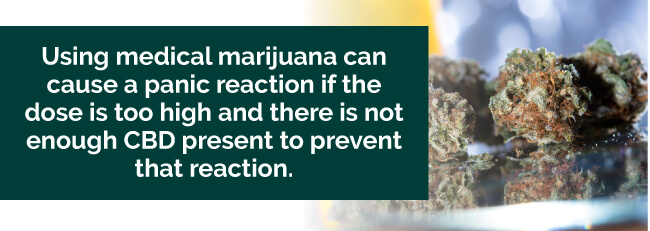
Hallucinations are a possible side effect of using medical marijuana, but not everyone who hallucinates is sorry. If you are taking medical marijuana for a terminal condition, you might welcome the hallucinations, the temporary escape from reality. If you take it to relieve nerve pain in your legs while you are driving your truck, the hallucinations would be a problem.
For patients taking medical marijuana with chemotherapy to ease nausea, increased appetite would be a welcomed side effect. Drowsiness might be the effect you were looking for if you used marijuana therapy to relieve insomnia. Most of these side effects can be managed with proper dosage and by choosing the right strain of medical marijuana for your condition.
The historic medical use for marijuana was in psychotherapy. Focusing on the psychotropic properties of marijuana, psychiatrists used it to bring out more information from the subconscious during talk therapy sessions. From a medical standpoint, marijuana was not an important component of psychotherapy.
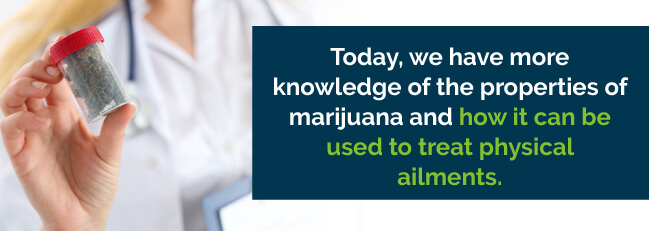
Today, we have more knowledge of the properties of marijuana and how it can be used to treat physical ailments. One of the first modern medical uses for marijuana was to ease pain and anxiety of the terminally ill and those undergoing chemotherapy.
The uses of medical marijuana have greatly expanded in the last couple decades. Medical marijuana treatment can be incorporated in the treatment of several conditions, including:
Some popular strains of medical marijuana help relieve chronic pain. Extreme pain can be debilitating and may not be relieved with other treatments. Medical marijuana reduces pain resulting from many different conditions. It is especially useful with pain from nerve damage.
Medical marijuana also relieves pain from severe muscle spasms. It can reduce the intensity and length of the spasms, reducing pain. This is an important treatment for people with degenerative muscle diseases that can be very painful.
The muscle-relaxing quality of medical marijuana can also reduce seizures. Associated with some chronic diseases, seizures are dangerous to the body and the brain. Injuries can occur during the uncontrollable movements of a seizure. If the person seizing hits their head on a hard surface or contacts a sharp object, they can suffer secondary injuries.
The seizure is caused by a series of electrical misfirings in the brain. The longer a seizure lasts, the greater risk of brain damage from the rapid misfiring of signals. Medical marijuana reduces the length and frequency of seizures by acting on the brain. Marijuana calms the muscle response system, preventing uncontrollable movements.
Medical marijuana can have the same appetite-stimulating effect as recreational marijuana does. In a medical setting, we can use that to benefit patients who are in danger of losing too much weight. Stimulating the appetite, especially for someone who is fighting a disease, can increase the nourishment and strength of the body’s natural immune system.
The suppression of nausea is still an important function of medical marijuana. Anyone undergoing chemotherapy is at risk for severe weight loss and malnutrition due to the nausea caused by the therapy. Medical marijuana makes chemotherapy a bit more tolerable to undergo and relieves nausea so the body can take in and process nutrition properly.
Unfortunately, the cost of medical marijuana is not covered by insurance the way other medicines are. That would require major changes to health insurance regulations and policy. Those changes are coming, especially now that several states have legalized the use of marijuana for medical purposes. There is no way, however, to predict when those changes will be made and implemented.
Medical marijuana is sold in several different forms, from dried leaves to concentrated tinctures. The amount of active ingredients you get is different in each form. When you smoke marijuana, for instance, you only consume a certain percentage of the active ingredients because some of it escapes in the second-hand smoke. Putting a drop of marijuana tincture under your tongue pretty much ensures you get the whole benefit of the active ingredients in that dose.
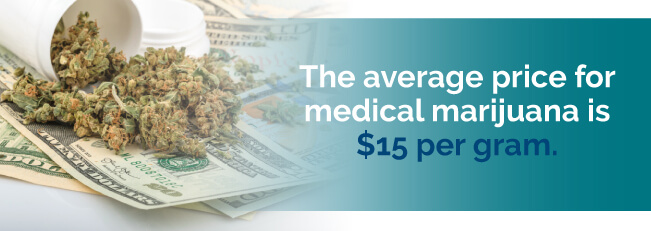
The average price for medical marijuana is $15 per gram. The price of medical marijuana remains fairly steady across the state because legal dispensaries are government regulated. From state to state, there could be some price variation, but it is not legal to import your medical marijuana from another state.
You could probably find cheaper marijuana on the street, but there is no way to compare the content and quality of that to the legal version at the dispensary. Not to mention buying marijuana on the street is illegal, even for registered marijuana patients.
Most dispensaries sell medical marijuana pre-rolled into small cigarettes in a five-pack that contains 3.5 grams of marijuana. At the average rate, that is a $52.50 pack of marijuana. The question is, how long will that last you, and how many packs will you have to buy to resolve your condition?
Of course, the amount of marijuana you need to consume varies greatly by the condition you are attempting to treat. A chronic condition may require medical marijuana treatment for the rest of your life, although the dose may change depending on how well-controlled your symptoms are.
If you are taking marijuana to ease the nausea of chemotherapy, the size of your doses could be larger than the average. When you are finished with chemotherapy, though, you should be able to stop your medical marijuana treatments as well.
Depending on the strain of marijuana you use, the THC and CBD doses in a single cigarette can be very different. The form of medical marijuana you use will also change the amount of active ingredients you consume. One drop of a marijuana tincture could be the equivalent dose of five pre-rolled cigarettes.
The average price of a one-ounce bottle of medical marijuana tincture is between $15 and $50 depending on the strength. You could also buy marijuana edibles for about $2 to $5 per dose. There may be several doses in one piece, however. To get a more concentrated product, like a wax or oil, you will spend $20 to $60 per gram.
The cost of the medical marijuana you would need to treat your particular condition can vary greatly. Your marijuana doctor will make a recommendation for the balance of THC and CBD that you need and how long your marijuana treatments will last.
He will also work with you to determine what form of medical marijuana might work best for you. Your input about any experience you have using marijuana and any limitations you have ingesting medicine will be helpful. Your marijuana doctor will help you with the broad range of medical marijuana products available.
To get more information about the best medical marijuana strains, sign up for the Marijuana Doctors newsletter. We publish a collection of news stories and medical reports concerning medical marijuana and include discounts and free giveaways. To learn more about using medical marijuana, use our website to search for a medical marijuana doctor or dispensary near you.
No Information on MarijuanaDoctors.Com should be used to diagnose, treat, prevent or cure any disease or condition. You can view our Full Disclaimer here.